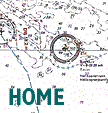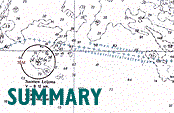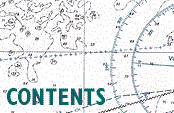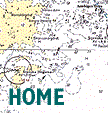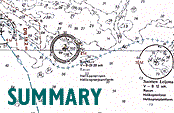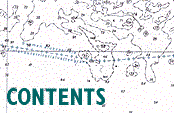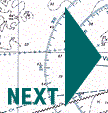CHAPTER 17 THE RESCUE OPERATION |
17.1 Introduction |
 |
The ESTONIA sank only about an hour after the first observations that presaged the accident and only about 30 minutes after the 1st Mayday call.
 About 680 - 750 people were trapped inside the vessel while at least 237 but probably 310 reached the outer decks. Lifejackets were distributed and liferafts were inflated and launched by the crew and by passengers. None of the ten lifeboats could be launched, but nine broke free and floated up to the surface when the vessel sank. About 680 - 750 people were trapped inside the vessel while at least 237 but probably 310 reached the outer decks. Lifejackets were distributed and liferafts were inflated and launched by the crew and by passengers. None of the ten lifeboats could be launched, but nine broke free and floated up to the surface when the vessel sank.
 The people who fell or jumped into the sea without lifejackets, and those who were badly injured, drowned or otherwise succumbed so quickly that no rescue organisation or unit could have reached them in time. The people who fell or jumped into the sea without lifejackets, and those who were badly injured, drowned or otherwise succumbed so quickly that no rescue organisation or unit could have reached them in time.
 Some 160 people succeeded in climbing onto liferafts or lifeboats. Of them, about 20 succumbed to hypothermia or hypothermia-induced drowning. At least two persons were lost during the rescue operation. Some 160 people succeeded in climbing onto liferafts or lifeboats. Of them, about 20 succumbed to hypothermia or hypothermia-induced drowning. At least two persons were lost during the rescue operation.
 The MARIELLA reached the accident scene 50 minutes after the 1st Mayday call, i.e. 20 minutes after the vessel sank. Four passenger ferries and the first rescue helicopter were on the scene within one hour and 10 minutes of the sinking. During the next three hours six more vessels and six more helicopters arrived. The MARIELLA reached the accident scene 50 minutes after the 1st Mayday call, i.e. 20 minutes after the vessel sank. Four passenger ferries and the first rescue helicopter were on the scene within one hour and 10 minutes of the sinking. During the next three hours six more vessels and six more helicopters arrived.
 Thirty-four people were rescued by the vessels and 104 by the helicopters in the time period between 0330 - 0900 hrs. Considering the circumstances a high percentage of people on the liferafts could be rescued. Almost all of those missing were trapped inside the vessel or were not able to get on a liferaft. Thirty-four people were rescued by the vessels and 104 by the helicopters in the time period between 0330 - 0900 hrs. Considering the circumstances a high percentage of people on the liferafts could be rescued. Almost all of those missing were trapped inside the vessel or were not able to get on a liferaft.
 In the plans and exercises considerable reliance had been placed on rescue vessels and lifeboats from passenger ferries and other vessels. The first rescue vessel, the TURSAS, arrived at the scene of the accident about three hours after the ESTONIA foundered. No lifeboats or MOB boats were lowered by the vessels on the scene. In the plans and exercises considerable reliance had been placed on rescue vessels and lifeboats from passenger ferries and other vessels. The first rescue vessel, the TURSAS, arrived at the scene of the accident about three hours after the ESTONIA foundered. No lifeboats or MOB boats were lowered by the vessels on the scene.
|
 |
17.2 The distress traffic |
 |
The ESTONIA addressed her distress calls to the passenger vessels in the vicinity. Also the form of the distress calls did not comply with the formal requirements of the radio regulations. The Commission has learned with regret that in this area distress messages nowadays are very seldom transmitted in the correct form.
 However, since the ESTONIA started the traffic by using the Mayday distress signal, the Commission considers that those receiving the message should have been in no doubt that the ESTONIA was requesting immediate assistance and that there was a distress situation on board. However, since the ESTONIA started the traffic by using the Mayday distress signal, the Commission considers that those receiving the message should have been in no doubt that the ESTONIA was requesting immediate assistance and that there was a distress situation on board.
 Almost the entire distress traffic was conducted in Finnish. This language was understood by the MRCCs and coast stations in the area, and on board the nine vessels nearest to the ESTONIA. Almost the entire distress traffic was conducted in Finnish. This language was understood by the MRCCs and coast stations in the area, and on board the nine vessels nearest to the ESTONIA.
 The ESTONIA was asked for, but could not give, her position immediately due to the list and ”black-out”. It took about seven minutes from the 1st Mayday call until the position was reported. No subsequent distress traffic was received from the ESTONIA. The ESTONIA was asked for, but could not give, her position immediately due to the list and ”black-out”. It took about seven minutes from the 1st Mayday call until the position was reported. No subsequent distress traffic was received from the ESTONIA.
 Several minutes passed before any station tried to re-establish radio contact. At 0139 hrs, i.e. 10 minutes after receiving the ESTONIA's position, the SILJA EUROPA called the ESTONIA very briefly and without result. No other station tried to contact the ESTONIA. Several minutes passed before any station tried to re-establish radio contact. At 0139 hrs, i.e. 10 minutes after receiving the ESTONIA's position, the SILJA EUROPA called the ESTONIA very briefly and without result. No other station tried to contact the ESTONIA.
 MRCC Turku did not acknowledge receipt of the distress message from the ESTONIA, thus not confirming that the centre was conducting the rescue operation. Therefore it was not known by the SILJA EUROPA and the MARIELLA whether the distress calls had been received by the coast radio stations, and both vessels spent a considerable time trying to contact Helsinki radio for information on the distress messages received. It is the opinion of the Commission that MRCC Turku should have acknowledged the distress message even though the message was addressed to the ferries. MRCC Turku did not acknowledge receipt of the distress message from the ESTONIA, thus not confirming that the centre was conducting the rescue operation. Therefore it was not known by the SILJA EUROPA and the MARIELLA whether the distress calls had been received by the coast radio stations, and both vessels spent a considerable time trying to contact Helsinki radio for information on the distress messages received. It is the opinion of the Commission that MRCC Turku should have acknowledged the distress message even though the message was addressed to the ferries.
 According to rescue instructions issued by the Finnish Ministry of the Interior, distress traffic should be handled by Helsinki Radio or Mariehamn Radio. This arrangement did not function as intended and, the Commission considers, contributed to information delays during the initial phase of the rescue operation. According to rescue instructions issued by the Finnish Ministry of the Interior, distress traffic should be handled by Helsinki Radio or Mariehamn Radio. This arrangement did not function as intended and, the Commission considers, contributed to information delays during the initial phase of the rescue operation.
 In the event, Helsinki Radio did not hear the ESTONIA's distress calls. Nor did Helsinki Radio respond to calls from the MARIELLA or the SILJA EUROPA on VHF channel 16 and on MF distress frequency 2182 kHz. The MARIELLA succeeded in contacting Helsinki Radio by mobile telephone (NMT) at 0142 hrs and reported the distress calls from the ESTONIA. After unsuccessful attempts to contact Helsinki Radio the SILJA EUROPA notified MRCC Helsinki of the distress calls also at around 0142 hrs. Two minutes later Helsinki Radio contacted the SILJA EUROPA on VHF channel 16, and at 0145 hrs Helsinki Radio responded to the MRCC Turku call on channel 16 without problems. In the event, Helsinki Radio did not hear the ESTONIA's distress calls. Nor did Helsinki Radio respond to calls from the MARIELLA or the SILJA EUROPA on VHF channel 16 and on MF distress frequency 2182 kHz. The MARIELLA succeeded in contacting Helsinki Radio by mobile telephone (NMT) at 0142 hrs and reported the distress calls from the ESTONIA. After unsuccessful attempts to contact Helsinki Radio the SILJA EUROPA notified MRCC Helsinki of the distress calls also at around 0142 hrs. Two minutes later Helsinki Radio contacted the SILJA EUROPA on VHF channel 16, and at 0145 hrs Helsinki Radio responded to the MRCC Turku call on channel 16 without problems.
 The Commission finds no other explanation of the fact that Helsinki Radio did not hear the distress traffic than that the distress frequencies were not kept watch continually. With only one officer on duty for many hours there must be, for natural reasons, periods when the watchkeeping will be interrupted. This was also noted and accepted in the agreement between the National Maritime Administration and Telecom Finland regarding the conduct of distress radio traffic. The Commission finds no other explanation of the fact that Helsinki Radio did not hear the distress traffic than that the distress frequencies were not kept watch continually. With only one officer on duty for many hours there must be, for natural reasons, periods when the watchkeeping will be interrupted. This was also noted and accepted in the agreement between the National Maritime Administration and Telecom Finland regarding the conduct of distress radio traffic.
 After contacting Helsinki Radio the SILJA EUROPA and the MARIELLA had good reasons to believe that Helsinki Radio would control the distress traffic. There was discussion on channel 16 between the vessels about transmitting a Mayday Relay but it was assumed that Helsinki Radio would do this. After contacting Helsinki Radio the SILJA EUROPA and the MARIELLA had good reasons to believe that Helsinki Radio would control the distress traffic. There was discussion on channel 16 between the vessels about transmitting a Mayday Relay but it was assumed that Helsinki Radio would do this.
 The Commission's opinion is that a Mayday Relay should have been transmitted, primarily by the vessels, immediately after the ESTONIA had reported her position to the SILJA EUROPA and, when they did not do this, by MRCC Turku and Helsinki Radio. Both the pre-GDMSS and the GDMSS procedures, as well as VHF and MF distress frequencies, could and should have been used. Had this been done, the coast stations and other vessels could have received the distress information simultaneously and without delay. The Commission's opinion is that a Mayday Relay should have been transmitted, primarily by the vessels, immediately after the ESTONIA had reported her position to the SILJA EUROPA and, when they did not do this, by MRCC Turku and Helsinki Radio. Both the pre-GDMSS and the GDMSS procedures, as well as VHF and MF distress frequencies, could and should have been used. Had this been done, the coast stations and other vessels could have received the distress information simultaneously and without delay.
 Finnish rescue instructions for radio traffic separate the controller of the distress traffic from the actual rescue organisation. In the ESTONIA case this was a contributing factor to the omission to transmit a Mayday Relay. The Commission considers this omission to be very serious. Finnish rescue instructions for radio traffic separate the controller of the distress traffic from the actual rescue organisation. In the ESTONIA case this was a contributing factor to the omission to transmit a Mayday Relay. The Commission considers this omission to be very serious.
 At 0145 hrs the operator at Helsinki Radio intended to transmit a Pan-Pan message. This was discussed with the duty officer at MRCC Helsinki and agreed to by him. At 0145 hrs the operator at Helsinki Radio intended to transmit a Pan-Pan message. This was discussed with the duty officer at MRCC Helsinki and agreed to by him.
 When MRCC Turku was informed by MRCC Helsinki that Helsinki Radio was going to transmit a Pan-Pan message, MRCC Turku contacted Helsinki Radio on VHF channel 16 and requested that a Mayday Relay should be transmitted. The Helsinki Radio operator responded that he was just preparing such a message. Notwithstanding this, the Helsinki Radio operator went ahead and transmitted the Pan-Pan message on channel 16 and 2182 kHz, reporting the ESTONIA's list and her Mayday calls. This was done at 0150 hrs, five minutes after MRCC Turku had requested a Mayday Relay to be transmitted, and some 20 minutes after the distress traffic from the ESTONIA had come to an end. When MRCC Turku was informed by MRCC Helsinki that Helsinki Radio was going to transmit a Pan-Pan message, MRCC Turku contacted Helsinki Radio on VHF channel 16 and requested that a Mayday Relay should be transmitted. The Helsinki Radio operator responded that he was just preparing such a message. Notwithstanding this, the Helsinki Radio operator went ahead and transmitted the Pan-Pan message on channel 16 and 2182 kHz, reporting the ESTONIA's list and her Mayday calls. This was done at 0150 hrs, five minutes after MRCC Turku had requested a Mayday Relay to be transmitted, and some 20 minutes after the distress traffic from the ESTONIA had come to an end.
 The Commission considers it remarkable that the Helsinki Radio operator neglected a request from the conductor of the rescue operation and that MRCC Turku did not take any corrective measures. The Commission considers it remarkable that the Helsinki Radio operator neglected a request from the conductor of the rescue operation and that MRCC Turku did not take any corrective measures.
 It is the opinion of the Commission that the alarms during the initial phase of the accident were late. The prime reason for this is believed to be the manning of the MRCCs and the radio stations, with only one man on duty. It was also too much for one person at MRCC Turku to initiate the alarms required in a major accident and at the same time follow the situation and take part in the distress traffic. It is the opinion of the Commission that the alarms during the initial phase of the accident were late. The prime reason for this is believed to be the manning of the MRCCs and the radio stations, with only one man on duty. It was also too much for one person at MRCC Turku to initiate the alarms required in a major accident and at the same time follow the situation and take part in the distress traffic.
 Consequences of the reduced manning at the MRCCs and the coast radio stations had been discussed in the organisation, and fears that the cost savings had resulted in insufficient resources for handling major accidents had been brought to the bodies responsible prior to the ESTONIA accident. Consequences of the reduced manning at the MRCCs and the coast radio stations had been discussed in the organisation, and fears that the cost savings had resulted in insufficient resources for handling major accidents had been brought to the bodies responsible prior to the ESTONIA accident.
 The manning had been decided in anticipation of conventional maritime accidents, when MRCCs were expected to be able to receive distress messages around the clock and to initiate rescue operations. The duty officer at MRCC Turku fulfilled these requirements, even though in the ESTONIA disaster the manning proved to be inadequate. The system was underdimensioned for a major maritime accident. The manning had been decided in anticipation of conventional maritime accidents, when MRCCs were expected to be able to receive distress messages around the clock and to initiate rescue operations. The duty officer at MRCC Turku fulfilled these requirements, even though in the ESTONIA disaster the manning proved to be inadequate. The system was underdimensioned for a major maritime accident.
 As noted in 8.11 the ESTONIA's emergency beacons (EPIRBs) were not switched on when put in their housings. The only reason that they were found switched off is that they were not properly activated. As noted in 8.11 the ESTONIA's emergency beacons (EPIRBs) were not switched on when put in their housings. The only reason that they were found switched off is that they were not properly activated.
|
 |
17.3 Responses to the Mayday calls |
 |
17.3.1 Vessels
Almost all the vessels that participated in the rescue operation arrived after hearing the ESTONIA's distress call or receiving information from another vessel in the vicinity. Only the vessels of the Finnish coast guard and navy were alerted by the coast stations.
 The positions of the vessels around the ESTONIA on 28 September 1994 at 0130 hrs are shown on the map in Figure 7.1. The positions of the vessels around the ESTONIA on 28 September 1994 at 0130 hrs are shown on the map in Figure 7.1.
 There were five passenger ferries in the Northern Baltic around the ESTONIA. Closest was the MARIELLA at a distance of about 9 NM and furthest was the Silja Symphony, 23 NM away. Within a 35-nautical-mile radius from the ESTONIA there were three more vessels that received her Mayday calls. There were five passenger ferries in the Northern Baltic around the ESTONIA. Closest was the MARIELLA at a distance of about 9 NM and furthest was the Silja Symphony, 23 NM away. Within a 35-nautical-mile radius from the ESTONIA there were three more vessels that received her Mayday calls.
 On hearing the 1. Mayday call, the MARIELLA tried twice to answer it but the ESTONIA did not reply. The officer of the watch saw the ESTONIA's lights and her radar image. According to a shore-based radar the MARIELLA started to turn towards the ESTONIA at 0132 hrs. The MARIELLA reached the scene of the accident at about 0210 hrs. On hearing the 1. Mayday call, the MARIELLA tried twice to answer it but the ESTONIA did not reply. The officer of the watch saw the ESTONIA's lights and her radar image. According to a shore-based radar the MARIELLA started to turn towards the ESTONIA at 0132 hrs. The MARIELLA reached the scene of the accident at about 0210 hrs.
 The SILJA EUROPA's was the only radio station that had contact with the ESTONIA. The information given from the ESTONIA reported only a severe list, a ”black-out”, that the situation looked serious and that assistance was needed. The extent of the accident and the assistance required were not known at this stage. The SILJA EUROPA's was the only radio station that had contact with the ESTONIA. The information given from the ESTONIA reported only a severe list, a ”black-out”, that the situation looked serious and that assistance was needed. The extent of the accident and the assistance required were not known at this stage.
 Figure 17.1 shows tracks of some vessels during the accident. The tracks are based on radar observations. Figure 17.1 shows tracks of some vessels during the accident. The tracks are based on radar observations.
Figure 17.1 Vessel’s tracks during the accident and rescue operation.
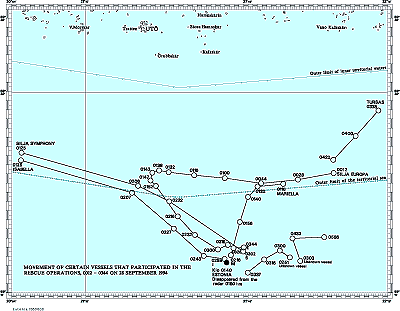 Click image for close-up
Click image for close-up
About 10 minutes elapsed between receipt of the 1st Mayday call and 2 minutes between receipt of the ESTONIA's position and the MARIELLA's change of course towards the accident site. Corresponding times for the SILJA EUROPA were 16 and 8 minutes. The Commission is of the opinion that a Mayday call from a large passenger ferry is in itself so alarming that the vessels should have changed course immediately. The rough position of the ESTONIA must have been known.
 The MRCC appointed the master of the SILJA EUROPA On-Scene Commander (OSC) at 0205 hrs. The MRCC appointed the master of the SILJA EUROPA On-Scene Commander (OSC) at 0205 hrs.
 The two other passenger ferries near the ESTONIA, the Silja Symphony and the ISABELLA, approached the ESTONIA from the west at full speed. Three other vessels approached the scene of the accident from the east. They reported to the OSC and took part in the search and rescue. Three vessels further west of the ESTONIA continued their voyage south-west. Two of them reported to the OSC and were released from the obligation to render assistance. The master of the third vessel considered that his ship in the circumstances was unable to provide assistance and he entered in the radio log the reason for this. The Commission considers that it was a reasonable judgement to let these three vessels proceed. The two other passenger ferries near the ESTONIA, the Silja Symphony and the ISABELLA, approached the ESTONIA from the west at full speed. Three other vessels approached the scene of the accident from the east. They reported to the OSC and took part in the search and rescue. Three vessels further west of the ESTONIA continued their voyage south-west. Two of them reported to the OSC and were released from the obligation to render assistance. The master of the third vessel considered that his ship in the circumstances was unable to provide assistance and he entered in the radio log the reason for this. The Commission considers that it was a reasonable judgement to let these three vessels proceed.
 The Commission considers that vessels in the vicinity, despite some delays in reaction, acted correctly. The Commission considers that vessels in the vicinity, despite some delays in reaction, acted correctly.
17.3.2 MRCCs and MRSCs
The accident took place within the rescue region of MRCC Turku. The rescue plan for major maritime accidents at that time included the alerting schedule shown in Figure 17.2.
Figure 17.2 Alerting plan for major maritime accident at MRCC Turku at the time of the accident.
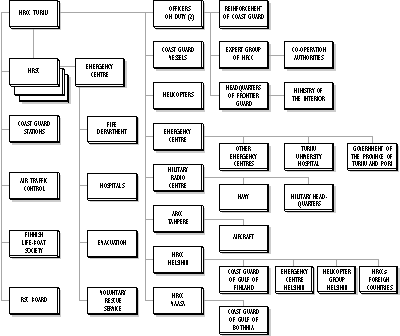 Click image for close-up
Click image for close-up
At the time of the accident there was only one officer on duty in MRCC Turku. According to the rescue plan for major maritime accidents the duty officer was responsible to:
- order the most rapid operational maritime rescue units to the scene of the accident to conduct the rescue operation at the scene and obtain a detailed assessment of the situation,
- alert the stand-by duty officer and the emergency duty officer,
- start general alerting according to the alerting schedule.
The duty officer's first action was to call MRSC Turku to confirm the distress message and to alert the coast guard patrol vessel TURSAS which was at anchor in the archipelago. This was done at 0126 hrs, or two minutes after the beginning of the 2nd Mayday call. The duty officer listened to the distress traffic until its end at 0130 hrs. At 0133 hrs he alerted the stand-by officer. After receiving the ESTONIA's exact position at 0129 hrs, at 0135 hrs he alerted the stand-by maritime rescue helicopter, which in the circumstances was the most rapid operational rescue unit. Between 0135 hrs and 0145 hrs he responded to telephone calls from crew members of the alerted helicopter.
 The stand-by duty officer arrived at 0140 hrs. On arrival he assumed responsibility for the operation of the centre. After assessing the situation, he spent five minutes contacting MRCC Helsinki and Helsinki radio in order to get a Mayday Relay transmitted. The stand-by duty officer arrived at 0140 hrs. On arrival he assumed responsibility for the operation of the centre. After assessing the situation, he spent five minutes contacting MRCC Helsinki and Helsinki radio in order to get a Mayday Relay transmitted.
 The emergency duty officer was not alerted until 0146 hrs. He arrived at 0203 hrs. The emergency duty officer was not alerted until 0146 hrs. He arrived at 0203 hrs.
 The first contact from MRCC Turku with vessels at sea took place somewhat before 0200 hrs, when the stand-by duty officer asked whether the master of the SILJA EUROPA agreed to lead the rescue operation at the scene of the accident. The first contact from MRCC Turku with vessels at sea took place somewhat before 0200 hrs, when the stand-by duty officer asked whether the master of the SILJA EUROPA agreed to lead the rescue operation at the scene of the accident.
 At 0152 hrs MRCC Stockholm was informed of the accident by MRSC Mariehamn which, in accordance with normal practice, contacted MRCC Stockholm to check whether they knew about the accident. After first calling MRCC Helsinki, at 0157 hrs MRCC Stockholm called MRCC Turku and offered helicopter assistance. At 0152 hrs MRCC Stockholm was informed of the accident by MRSC Mariehamn which, in accordance with normal practice, contacted MRCC Stockholm to check whether they knew about the accident. After first calling MRCC Helsinki, at 0157 hrs MRCC Stockholm called MRCC Turku and offered helicopter assistance.
 At 0218 hrs MRCC Turku ordered MRCC Helsinki to alert the stand-by rescue helicopter in Helsinki. The crew was called at 0221 hrs. At 0252 hrs MRCC Turku alerted the Aeronautical Rescue Co-ordination Centre (ARCC) at Tampere to obtain military helicopters from the Transport Flight at Utti. At 0258 hrs the ARCC called the Air Force control centre and requested as many Air Force helicopters as possible. All these alerts of helicopters were late. At 0218 hrs MRCC Turku ordered MRCC Helsinki to alert the stand-by rescue helicopter in Helsinki. The crew was called at 0221 hrs. At 0252 hrs MRCC Turku alerted the Aeronautical Rescue Co-ordination Centre (ARCC) at Tampere to obtain military helicopters from the Transport Flight at Utti. At 0258 hrs the ARCC called the Air Force control centre and requested as many Air Force helicopters as possible. All these alerts of helicopters were late.
 By 0200 hrs the seriousness of the accident had been realised and the MRCC Turku commander and deputy commander were alerted. It was not until 0230 hrs, or about ten minutes after the arrival of the deputy commander, that MRCC Turku determined formally that the situation was a major accident and began to summon the members of the maritime rescue expert group to MRCC Turku. The members of the group, in turn, alerted their own organisations, informed them of the situation and passed on assignments, and received from them reports on their action and on the situation. By 0200 hrs the seriousness of the accident had been realised and the MRCC Turku commander and deputy commander were alerted. It was not until 0230 hrs, or about ten minutes after the arrival of the deputy commander, that MRCC Turku determined formally that the situation was a major accident and began to summon the members of the maritime rescue expert group to MRCC Turku. The members of the group, in turn, alerted their own organisations, informed them of the situation and passed on assignments, and received from them reports on their action and on the situation.
 As the Commission states above, a Mayday call from a large passenger ferry must be considered a most alarming situation and immediately assessed as a major accident. Clearly, the instructions and the manning were inappropriate for coping with an accident of this magnitude. For this reason the rescue plan for major maritime accidents was not fully complied with. Among other things the summoning of MRCC Turku personnel was delayed. Further, MRCC Turku did not announce on the radio that they were conducting the rescue operation. As the Commission states above, a Mayday call from a large passenger ferry must be considered a most alarming situation and immediately assessed as a major accident. Clearly, the instructions and the manning were inappropriate for coping with an accident of this magnitude. For this reason the rescue plan for major maritime accidents was not fully complied with. Among other things the summoning of MRCC Turku personnel was delayed. Further, MRCC Turku did not announce on the radio that they were conducting the rescue operation.
 Another shortcoming was that no mission co-ordinator, as recommended in the SAR Convention, was designated. This function was at first performed by the duty officer. The stand-by duty officer took over on his arrival and was relieved by the emergency duty officer on his arrival. He in turn was relieved by the deputy commander, and lastly by the commander. Continuity was maintained through briefings at each change. A system with so many changes is not considered efficient, since so much time and energy is required to ensure continuity. Another shortcoming was that no mission co-ordinator, as recommended in the SAR Convention, was designated. This function was at first performed by the duty officer. The stand-by duty officer took over on his arrival and was relieved by the emergency duty officer on his arrival. He in turn was relieved by the deputy commander, and lastly by the commander. Continuity was maintained through briefings at each change. A system with so many changes is not considered efficient, since so much time and energy is required to ensure continuity.
 With the deputy commander's arrival at 0220 hrs there were four rescue officers working at MRCC Turku. Even this group proved to be far too small for a rescue operation of this magnitude and it was not until the members of the maritime rescue expert group arrived that capacity was sufficient. With the deputy commander's arrival at 0220 hrs there were four rescue officers working at MRCC Turku. Even this group proved to be far too small for a rescue operation of this magnitude and it was not until the members of the maritime rescue expert group arrived that capacity was sufficient.
 The personnel at MRCC Turku was divided into four groups. The operational group of three officers and two warrant officers maintained an overview of the situation, considered and ordered action and assisted the commander. The communication group was responsible for radio and telephone communications. It consisted of three warrant officers trained in communications. The maritime rescue expert group consisted of experts from various fields of importance for rescue operations. Each member of the group had his own area of responsibility. The public information group, finally, took care of information functions, and arranged briefings for the media and various official delegations. In spite of the work of this group these briefings also tied up a considerable amount of the commander's working capacity. The personnel at MRCC Turku was divided into four groups. The operational group of three officers and two warrant officers maintained an overview of the situation, considered and ordered action and assisted the commander. The communication group was responsible for radio and telephone communications. It consisted of three warrant officers trained in communications. The maritime rescue expert group consisted of experts from various fields of importance for rescue operations. Each member of the group had his own area of responsibility. The public information group, finally, took care of information functions, and arranged briefings for the media and various official delegations. In spite of the work of this group these briefings also tied up a considerable amount of the commander's working capacity.
 It is the opinion of the Commission that despite initial difficulties the work improved after the first hour and functioned well. Decisions were made and accomplished quickly under the commander's overall control. It is the opinion of the Commission that despite initial difficulties the work improved after the first hour and functioned well. Decisions were made and accomplished quickly under the commander's overall control.
|
 |
17.4 Readiness of the rescue units |
 |
The Gulf of Finland and the Northern Baltic form a significant focus for maritime rescue services since on the average 34,000 passengers cross this small sea area every day. The Helsinki, Turku and Berga helicopter bases are on the fringes of this area (Figure 17.3). Any passenger vessel using the main ship routes can be reached from these bases in less than two hours. The location of the Turku base at the half-way point of the main route is considered appropriate, although the best accessibility and the shortest flight time would be from the Hanko peninsula.
Figure 17.3 Bases of helicopters participating in the rescue operation.
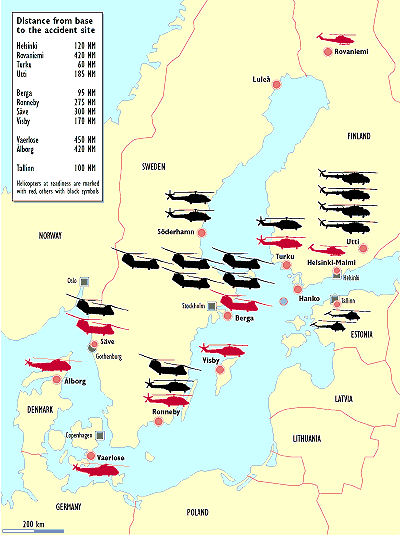
Three Finnish helicopters were on stand-by at various bases. The crews were on one-hour alert, meaning that they should be assembled within that time. Three of the Swedish stand-by helicopters should be ready to depart within one hour, and one should be ready to depart within two hours. All stand-by helicopters fulfilled the requirements. The first helicopters took off earlier than their alert times required.
 It is of utmost importance in an accident like this one that rescue helicopters reach the accident scene fast, as survival time in cold water is short. It is the view of the Commission that stand-by times can be shortened, with minimum costs, through: It is of utmost importance in an accident like this one that rescue helicopters reach the accident scene fast, as survival time in cold water is short. It is the view of the Commission that stand-by times can be shortened, with minimum costs, through:
- more efficient ways of alerting helicopter crews and other personnel required for take off, e.g. by using more modern technology,
- briefing the crews during transport to the helicopter bases and during the initial phase of the flight,
- speeding up transport times to the bases, especially for crew members living far from the bases.
The contribution of maritime rescue vessels remained small. Some arrived late at the scene of the accident because of the delay in alerting them and their slow speed in the prevailing weather with strong head wind. Some smaller rescue vessels on stand-by a few hours' sailing time away from the scene of the accident were not alerted, which the Commission considers an acceptable decision in the circumstances.
|
 |
17.5 Management |
 |
17.5.1 MRCC Turku
The organisation and chain of command of the maritime SAR services of Estonia, Finland and Sweden were established on the principles outlined by the IMO. The northern part of the Baltic Sea was divided into regions of responsibility of three MRCCs, Turku, Stockholm and Tallinn. The basic principle was for the MRCC responsible for the region to conduct the operation, while the others provided support as requested. Exceptional arrangements could be made as necessary.
 As stated above, MRCC Turku assumed the responsibility for the rescue operation on receiving the Mayday calls. MRCC Turku had recently been restructured, and its organisation and communications equipment had been modernised. As stated above, MRCC Turku assumed the responsibility for the rescue operation on receiving the Mayday calls. MRCC Turku had recently been restructured, and its organisation and communications equipment had been modernised.
 The internal chain of command was clear and simple. The commander was ultimately responsible for rescue operations, and he had at his disposal the staff and the maritime rescue expert group. The work of the expert group had been practised, and procedures for alerting the members were in working order. The internal chain of command was clear and simple. The commander was ultimately responsible for rescue operations, and he had at his disposal the staff and the maritime rescue expert group. The work of the expert group had been practised, and procedures for alerting the members were in working order.
 Co-operation between the different national rescue services was governed by a 1985 Finnish Ministry of the Interior instruction on conducting and maintaining maritime rescue services. The instruction stated that ”the Headquarters of the Frontier Guard conducts, co-ordinates and oversees the co-operation among maritime rescue services, assisted as necessary by the maritime rescue division of the National Consultative Board for Rescue Services”. Co-operation between the different national rescue services was governed by a 1985 Finnish Ministry of the Interior instruction on conducting and maintaining maritime rescue services. The instruction stated that ”the Headquarters of the Frontier Guard conducts, co-ordinates and oversees the co-operation among maritime rescue services, assisted as necessary by the maritime rescue division of the National Consultative Board for Rescue Services”.
 Contrary to the instruction, the tasks were carried out by the Security and Safety Management Group, headed by the Minister of the Interior. This body provided no practical assistance in the operative conduct of the rescue action. In the event of a major accident like the ESTONIA accident all measures should have been taken to support MRCC Turku. Contrary to the instruction, the tasks were carried out by the Security and Safety Management Group, headed by the Minister of the Interior. This body provided no practical assistance in the operative conduct of the rescue action. In the event of a major accident like the ESTONIA accident all measures should have been taken to support MRCC Turku.
 Already before the ESTONIA accident there had been criticism among the personnel of the Finnish Frontier Guard, pointing out that insufficient attention was given to the SAR service. Already before the ESTONIA accident there had been criticism among the personnel of the Finnish Frontier Guard, pointing out that insufficient attention was given to the SAR service.
17.5.2 The On-Scene Commander (OSC)
The master of the SILJA EUROPA was appointed OSC although this was not in line with the SAR Convention. The decision was a logical consequence of the fact that the SILJA EUROPA managed the distress traffic and thus served as control station for the traffic. The master of the SILJA EUROPA was also personally known to those at MRCC Turku, and was deemed capable of carrying out these demanding duties.
 Although the master of the SILJA EUROPA carried out his duties and responsibilities as OSC in exemplary fashion without proper training or earlier experience, it is the opinion of the Commission that it is appropriate to provide selected masters of vessels in this traffic with the training needed to conduct such operations. Although the master of the SILJA EUROPA carried out his duties and responsibilities as OSC in exemplary fashion without proper training or earlier experience, it is the opinion of the Commission that it is appropriate to provide selected masters of vessels in this traffic with the training needed to conduct such operations.
 During the first hours the entire rescue operation was conducted by the OSC himself, assisted only by his own crew. On his instructions the vessels searched for and rescued survivors. When a vessel located a liferaft that was believed to contain survivors, this was reported to the OSC who either called on a helicopter to check this raft or broadcast a general message. The participating vessels sometimes also contacted the helicopters directly. During the first hours the entire rescue operation was conducted by the OSC himself, assisted only by his own crew. On his instructions the vessels searched for and rescued survivors. When a vessel located a liferaft that was believed to contain survivors, this was reported to the OSC who either called on a helicopter to check this raft or broadcast a general message. The participating vessels sometimes also contacted the helicopters directly.
 The helicopters arriving on the scene of the accident reported to the OSC and were assigned a mission. With the increasing number of helicopters the OSC had difficulties in overseeing their operations. The helicopters arriving on the scene of the accident reported to the OSC and were assigned a mission. With the increasing number of helicopters the OSC had difficulties in overseeing their operations.
 At 0650 hrs additional resources were flown out to assist the OSC. An air operation co-ordinator was then landed on board the SILJA EUROPA. He took over control of the air operation in the area. A co-ordinator surface search, appointed by MRCC Turku, with an assistant and an air traffic controller left Nauvo by helicopter at 0700 hrs but did not reach the vessel until 0945 hrs, since the helicopter that they first used could not land on the vessel or winch them on board. At 0650 hrs additional resources were flown out to assist the OSC. An air operation co-ordinator was then landed on board the SILJA EUROPA. He took over control of the air operation in the area. A co-ordinator surface search, appointed by MRCC Turku, with an assistant and an air traffic controller left Nauvo by helicopter at 0700 hrs but did not reach the vessel until 0945 hrs, since the helicopter that they first used could not land on the vessel or winch them on board.
 At the beginning of the operation, when there were many liferafts in a small area, the helicopters acted independently. When the air operation co-ordinator took over the control of the air operation, he gave the incoming helicopters their instructions and informed them of other helicopters in the area. He also gave them instructions and orders regarding the rescue operation management, e.g. regarding refuelling possibilities. Later on he assigned search areas, and in practice managed the air operation. At the beginning of the operation, when there were many liferafts in a small area, the helicopters acted independently. When the air operation co-ordinator took over the control of the air operation, he gave the incoming helicopters their instructions and informed them of other helicopters in the area. He also gave them instructions and orders regarding the rescue operation management, e.g. regarding refuelling possibilities. Later on he assigned search areas, and in practice managed the air operation.
 The safety of the helicopters engaged in the rescue operations depended mainly on radio communications on the overloaded distress frequencies, since the air traffic radars were unable to follow the helicopters at low altitudes and there was no supervision and tracking system over the sea. The Commission's opinion is that the professional skill and experience of the helicopter crews contributed in a positive way to the outcome of the rescue operation. The safety of the helicopters engaged in the rescue operations depended mainly on radio communications on the overloaded distress frequencies, since the air traffic radars were unable to follow the helicopters at low altitudes and there was no supervision and tracking system over the sea. The Commission's opinion is that the professional skill and experience of the helicopter crews contributed in a positive way to the outcome of the rescue operation.
 In this kind of major air operation, it is essential that the OSC is assisted by personnel with experience of air traffic control. The air operation co-ordinator was not in place during the critical hours of darkness and the air traffic controller needed for supervising the air traffic and for ensuring flight safety did not arrive until 0945 hrs. In this kind of major air operation, it is essential that the OSC is assisted by personnel with experience of air traffic control. The air operation co-ordinator was not in place during the critical hours of darkness and the air traffic controller needed for supervising the air traffic and for ensuring flight safety did not arrive until 0945 hrs.
 When the co-ordinator surface search and the air operation co-ordinator and his assistant had arrived on board the SILJA EUROPA, the staff of the OSC is considered to have reached a standard sufficient for conducting an operation of this magnitude. However, this did not happen until about 45 minutes after the last survivors were found. When the co-ordinator surface search and the air operation co-ordinator and his assistant had arrived on board the SILJA EUROPA, the staff of the OSC is considered to have reached a standard sufficient for conducting an operation of this magnitude. However, this did not happen until about 45 minutes after the last survivors were found.
|
 |
17.6 Action at the accident site |
 |
17.6.1 Vessels
On-board preparations
While proceeding to the scene of the accident the assisting vessels made necessary preparations for the rescue operation and for taking care of survivors.
 The helicopter pads were prepared for landings. Reception and treatment facilities for the survivors were readied and nursing staffs prepared. Voluntary medical experts among passengers were alerted to assist the permanent staffs. The preparations on board and the professionalism and willingness of people to help were afterwards highly appreciated by the survivors. The helicopter pads were prepared for landings. Reception and treatment facilities for the survivors were readied and nursing staffs prepared. Voluntary medical experts among passengers were alerted to assist the permanent staffs. The preparations on board and the professionalism and willingness of people to help were afterwards highly appreciated by the survivors.
 No lifeboats or rescue boats were launched from the vessels participating in the rescue operation. The possibilities of launching boats were discussed between some of the masters, but in the prevailing weather the operation was considered too risky. Instead liferafts were prepared for use and in some ferries the possibilities of using evacuation slides were discussed and the slides prepared. No lifeboats or rescue boats were launched from the vessels participating in the rescue operation. The possibilities of launching boats were discussed between some of the masters, but in the prevailing weather the operation was considered too risky. Instead liferafts were prepared for use and in some ferries the possibilities of using evacuation slides were discussed and the slides prepared.
 The masters realised that the rescue operations would be difficult and the possibilities of rescuing people from the water were limited when lifeboats and rescue boats could not be used. The masters realised that the rescue operations would be difficult and the possibilities of rescuing people from the water were limited when lifeboats and rescue boats could not be used.
Rescues from vessels
On the MARIELLA an inflated liferaft was placed at each end of the vessel's flat side. The vessel was manoeuvred with that side towards the wind and caught drifting rafts from the ESTONIA in between them. Another raft was lowered and used as a hoistable platform. People from the ESTONIA's liferafts moved over to the lowered raft and were winched up. The winches on the liferaft davits were manually operated, but during operations electric drilling machines were converted and used to improve the winching speed.
 Two volunteers from the MARIELLA were lowered to a liferaft from which they managed to rescue two exhausted persons in another liferaft. Two volunteers from the MARIELLA were lowered to a liferaft from which they managed to rescue two exhausted persons in another liferaft.
 The ISABELLA also lowered a liferaft with volunteer rescuers on board. The ISABELLA also lowered a liferaft with volunteer rescuers on board.
 They succeeded in getting about 20 people from one of the ESTONIA's rafts over to their own raft. The weight of the people and the water in the liferaft caused its bottom to rip during hoisting. At least five people fell into the sea, among them the three rescuemen. Four of these people were lifted up by a helicopter. One or more persons were lost during this operation. They succeeded in getting about 20 people from one of the ESTONIA's rafts over to their own raft. The weight of the people and the water in the liferaft caused its bottom to rip during hoisting. At least five people fell into the sea, among them the three rescuemen. Four of these people were lifted up by a helicopter. One or more persons were lost during this operation.
 To save the 16 persons hanging onto the damaged liferaft, the evacuation slide was inflated and the raft lowered back to the sea. A rescueman was lowered down to the slide platform and assisted people in getting from the raft to the platform and up the slide. The evacuation slide proved to be a good means of rescuing people from the rafts and from the sea. From the platform people were pulled up the slide itself to safety. To save the 16 persons hanging onto the damaged liferaft, the evacuation slide was inflated and the raft lowered back to the sea. A rescueman was lowered down to the slide platform and assisted people in getting from the raft to the platform and up the slide. The evacuation slide proved to be a good means of rescuing people from the rafts and from the sea. From the platform people were pulled up the slide itself to safety.
 The decision to inflate the evacuation slide was quite extraordinary in the circumstances and testifies to good creative thinking. The decision to inflate the evacuation slide was quite extraordinary in the circumstances and testifies to good creative thinking.
 Although the participating vessels contributed to the rescuing of many lives, it is established that their suitability for rescue operation in these severe weather conditions was limited. The safe launching of rescue boats or lifeboats was considered impossible, and rescuing people directly onto the vessels proved very difficult. The boat deck on the ferries, in most cases the only open deck, was situated more than 15 m above the water and lifting the survivors on board proved both risky and difficult. The experience of the rescue highlights the importance of having appliances permitting large ferries to recover people and liferafts from the surface. It also points out the need for liferafts to be strong enough to withstand lifting from the sea with full load. Although the participating vessels contributed to the rescuing of many lives, it is established that their suitability for rescue operation in these severe weather conditions was limited. The safe launching of rescue boats or lifeboats was considered impossible, and rescuing people directly onto the vessels proved very difficult. The boat deck on the ferries, in most cases the only open deck, was situated more than 15 m above the water and lifting the survivors on board proved both risky and difficult. The experience of the rescue highlights the importance of having appliances permitting large ferries to recover people and liferafts from the surface. It also points out the need for liferafts to be strong enough to withstand lifting from the sea with full load.
17.6.2 Helicopters
The helicopter operation
When the first helicopter, OH-HVG, arrived at the scene of the accident at 0305 hrs, no one was yet able to give its crew an exact description of the situation. The crew assumed that people who had been able to leave the vessel were floating on liferafts or were in the sea. On the way to the scene of the accident the crew had decided that they would first try to rescue those who were in the water, and only then begin to rescue people from liferafts and lifeboats. On arrival the helicopter flew at a height of about 20 m, the crew searching for survivors in the light of the searchlights. The crew saw a number of lifejackets and liferafts but no people in the water. For this reason, some ten minutes after arrival, they began to examine the liferafts and rescue survivors from these. At this stage the helicopter had not yet received any rescue instructions from those responsible for conducting the operations (the OSC or MRCC Turku); so the crew had to make the decisions on its own.
 When the two following helicopters Q 97 and Y 65 arrived on the scene at about 0400 hrs, they reported to the OSC and received instructions from him to concentrate on rescuing the survivors and for the time being leave those who were clearly dead. When the two following helicopters Q 97 and Y 65 arrived on the scene at about 0400 hrs, they reported to the OSC and received instructions from him to concentrate on rescuing the survivors and for the time being leave those who were clearly dead.
 Because of large wave-induced motions, landing on the vessels was very difficult. Few crews were trained for landing on vessels in heavy weather. Only the Finnish helicopters OH-HVG and OH-HVD made successful ship landings, setting down 36 people. The ability of helicopters to land on large passenger ferries in adverse weather conditions during rescue operations should be improved. Because of large wave-induced motions, landing on the vessels was very difficult. Few crews were trained for landing on vessels in heavy weather. Only the Finnish helicopters OH-HVG and OH-HVD made successful ship landings, setting down 36 people. The ability of helicopters to land on large passenger ferries in adverse weather conditions during rescue operations should be improved.
 The Swedish helicopters took survivors primarily to Utö, but also to Hanko, Mariehamn or Huddinge Hospital in Sweden. The justification for these flights could be found in technical problems (e.g. a failed winch, an engine failure warning lamp). The pilot of the Q 97 had noted even on the first rescue flight that the survivors were in such bad condition that they had to be transported directly to the mainland for immediate hospitalisation. For this reason he flew directly to Hanko and landed on a sports field. No arrangements had been made in Hanko for receiving the patients, but local citizens helped in quickly transferring the survivors from the helicopter for treatment and care. The Swedish helicopters took survivors primarily to Utö, but also to Hanko, Mariehamn or Huddinge Hospital in Sweden. The justification for these flights could be found in technical problems (e.g. a failed winch, an engine failure warning lamp). The pilot of the Q 97 had noted even on the first rescue flight that the survivors were in such bad condition that they had to be transported directly to the mainland for immediate hospitalisation. For this reason he flew directly to Hanko and landed on a sports field. No arrangements had been made in Hanko for receiving the patients, but local citizens helped in quickly transferring the survivors from the helicopter for treatment and care.
 The medical specialists of the expert group at MRCC Turku, beginning work soon after 0300 hrs, decided that the survivors should be brought to the vessels or to Utö without delay to lessen the risk of hypothermia. The flight from the scene of the accident took five to ten minutes to the vessels, 10 to 15 minutes to Utö, 20 to 25 minutes to Mariehamn, Nauvo and Hanko, and 25 to 30 minutes to Turku. The medical specialists of the expert group at MRCC Turku, beginning work soon after 0300 hrs, decided that the survivors should be brought to the vessels or to Utö without delay to lessen the risk of hypothermia. The flight from the scene of the accident took five to ten minutes to the vessels, 10 to 15 minutes to Utö, 20 to 25 minutes to Mariehamn, Nauvo and Hanko, and 25 to 30 minutes to Turku.
 When MRCC Turku was informed that it was considered dangerous to land helicopters on the vessels it was decided to use primarily Utö, where medical personnel and facilities were available. When MRCC Turku was informed that it was considered dangerous to land helicopters on the vessels it was decided to use primarily Utö, where medical personnel and facilities were available.
 The diagram in Figure 17.4 shows the number of helicopters at the scene at different times, and the numbers of survivors rescued. The diagram is partly based on estimates. Since the times at which survivors were winched were not logged, the numbers rescued during an individual flight have been distributed evenly over the entire flight time. Helicopters are considered to have been in the area of the accident even when they were transporting survivors to a vessel or to Utö. Helicopters flying survivors further than this are deemed to have left the scene of the accident at the estimated time of departure. The diagram in Figure 17.4 shows the number of helicopters at the scene at different times, and the numbers of survivors rescued. The diagram is partly based on estimates. Since the times at which survivors were winched were not logged, the numbers rescued during an individual flight have been distributed evenly over the entire flight time. Helicopters are considered to have been in the area of the accident even when they were transporting survivors to a vessel or to Utö. Helicopters flying survivors further than this are deemed to have left the scene of the accident at the estimated time of departure.
Figure 17.4 Summary of the rescue operation by helicopters, number of persons rescued and time.
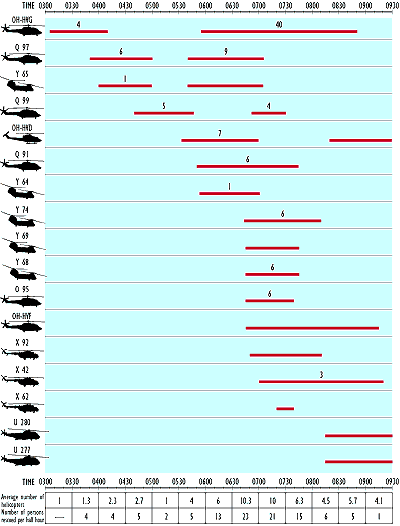
Problems in action
At a time when survivors could still have been rescued, the winch wires on three Boeing Kawasaki helicopters malfunctioned, and the winch mechanism on one of these broke down. These helicopters had to interrupt the rescue operation for several hours, and one was transferred to transport duties. The survivors and rescue men who were left on the rafts or the sea when the winches malfunctioned were rescued by other helicopters, and one rescue man was transported, hanging onto the wire, to the deck of a vessel. These operations reduced the resources available for the rescue work. The unreliable operation of these winches had been identifield prior to this accident and had also been reported to responsible parties as constituting a hazard to the rescue men. Unfortunately, however, no action had been taken. The fourth helicopter, a Super Puma, had an indicated engine problem and had to return to base.
 The helicopters operational period was limited by fuel and the fatique of the rescue men. Using two rescue men made it possible to continue as long as fuel lasted. The rescue work was very exhausting both physically and mentally. Already on the first helicopter on the scene the pilot noted that one rescue man was not enough. The man became quickly exhausted and thus the limiting factor of the operation. The helicopters operational period was limited by fuel and the fatique of the rescue men. Using two rescue men made it possible to continue as long as fuel lasted. The rescue work was very exhausting both physically and mentally. Already on the first helicopter on the scene the pilot noted that one rescue man was not enough. The man became quickly exhausted and thus the limiting factor of the operation.
 Many of the rescue men were also injured, more or less seriously, by hooks and by objects in the water such as lifeboats. Many of the rescue men were also injured, more or less seriously, by hooks and by objects in the water such as lifeboats.
 It has subsequently been noted by many rescue men that in such conditions, with violent movements of the rafts causing the wires to jerk severely, the NATO harness, in which the rescue man is in a sitting position, would have been more appropriate. It has subsequently been noted by many rescue men that in such conditions, with violent movements of the rafts causing the wires to jerk severely, the NATO harness, in which the rescue man is in a sitting position, would have been more appropriate.
 The rescue men had had varying training and experience, since the group included soldiers and border guard men on active duty, firemen and, in the helicopters of the Swedish Air Force, conscripts. There is no indication that the training of the rescue men was insufficient, but it is the opinion of the Commission that in rescue operations when more than a few persons are expected to be recovered from the water the participating helicopters should carry at least two rescue men. The rescue men had had varying training and experience, since the group included soldiers and border guard men on active duty, firemen and, in the helicopters of the Swedish Air Force, conscripts. There is no indication that the training of the rescue men was insufficient, but it is the opinion of the Commission that in rescue operations when more than a few persons are expected to be recovered from the water the participating helicopters should carry at least two rescue men.
 At the beginning of the operation, the rafts that had been searched were not marked in any way. As a result, the same raft could have been searched several times. Later during the operations, instructions were given to mark searched rafts by ripping open the roof with a knife. At the beginning of the operation, the rafts that had been searched were not marked in any way. As a result, the same raft could have been searched several times. Later during the operations, instructions were given to mark searched rafts by ripping open the roof with a knife.
 At about 0630 hrs the helicopter fuel supply at Utö ran out. After this, the helicopters flew the survivors and the deceased to Hanko or Nauvo, where refuelling took place. The fuel supply at Hanko, in turn, ran out at about 1000 hrs, and five helicopters had to wait for half an hour for a new supply. At about 0630 hrs the helicopter fuel supply at Utö ran out. After this, the helicopters flew the survivors and the deceased to Hanko or Nauvo, where refuelling took place. The fuel supply at Hanko, in turn, ran out at about 1000 hrs, and five helicopters had to wait for half an hour for a new supply.
Continues... |
 |

